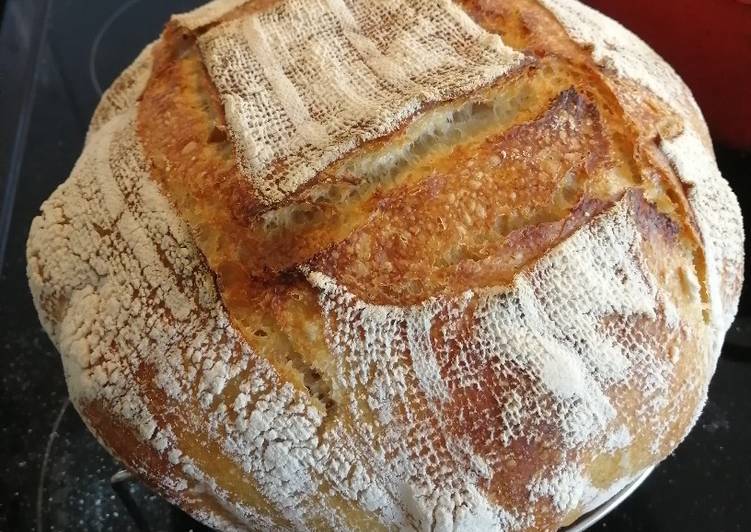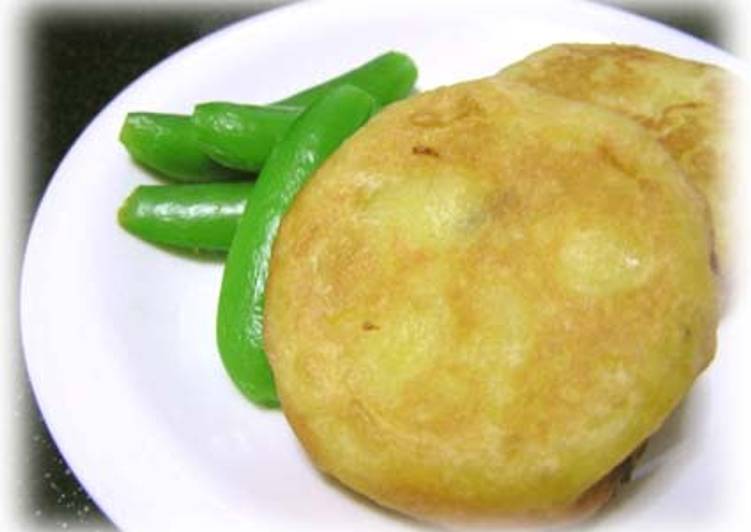
Hello everybody, I hope you are having an incredible day today. Today, I’m gonna show you how to make a special dish, sourdough bloomer. One of my favorites. This time, I am going to make it a bit unique. This will be really delicious.
Bloomer as it's called, because it expands on the slash lines as it bakes and so it 'blooms'. It is a bread with a slightly chewy crust and a soft moist crumb. The most common use is to make great sandwiches and toasties.
Sourdough bloomer is one of the most well liked of recent trending foods on earth. It is easy, it is fast, it tastes delicious. It is appreciated by millions daily. They are fine and they look fantastic. Sourdough bloomer is something that I have loved my whole life.
To get started with this particular recipe, we must prepare a few ingredients. You can have sourdough bloomer using 5 ingredients and 10 steps. Here is how you cook it.
The ingredients needed to make Sourdough bloomer:
- Get 450 g bread flour
- Get 50 g kamut flour
- Prepare 100 g sourdough starter
- Make ready 350 ml warm water
- Prepare 20 ml water mixed with 10g salt
I always think of bloomer bread as bread with quite a soft loaf so it is interesting to hear that it is crusty. Add Tesco Sourdough Rye Bloomer Add add Tesco Sourdough Rye Bloomer to basket. Our recipe for success begins with a deep understanding of food. Sourdough is a stable culture of lactic acid bacteria and yeast in a mixture of flour and water.
Instructions to make Sourdough bloomer:
- In a large bowl, mix together the bread and kamut flour, the warm water and the sourdough starter, then cover with a hot wet cloth and leave to rest for 30 mins at room temperature, to allow all the ingredients to bond
- Add the salted water to the mixture and knead together. Adding the salt now will help tighten up the dough, allowing you to tuck the sides under to shape. Cover with a wet cloth and leave to rest for 30 mins at room temperature
- Now stretch and fold your dough, to let that gluten work and create some structure. To do so, grab a "corner" of your dough and gently pull it outward, stretching and waving it, then fold it on its own. Repeat until the edges all around the dough have been pulled and folded. Cover with a wet cloth and leave to rest for 30 mins at room temperature
- Repeat step 3 about 5-6 times, letting your dough rest for 30mins in between stretches. Then let it rest for at least 1-2 hours
- Now you can shape: get your dough on a floured surface, and pull it into a square. Now fold the corners in, in a cross stitch manner. Then fold it 4 times on its own: pull the bottom 1 third up, then the top 1 third down, and the left and right sides 1 third in. Turn your dough upside down, and start sliding it on the surface in order to tighten and seal the bottom. Let it rest a few seconds, to allow the dough to completely seal underneath
- Time for proofing: generously flour your proofing basket (or you can use a bowl lined with a dry, clean tea towel like I do) and tip your dough in it upside down. Cover and let it rest at room temperature for 1-2hours, then in the fridge overnight
- Once the dough has risen, preheat your oven at 220°, and leave your casserole or dutch oven in it to get really hot. Once you reached your temperature, flour the casserole or dutch oven, or line with a baking sheet, the tip the dough into it, and score the top of with a sharp knife. Cover with a lid and bake for 20 minutes. Leave a tray full of water in the oven during baking time, to allow extra moisture in
- After 20 minutes, remove the lid and bake for another 20 minutes
- Once the bread has cooked for 40 minutes, take it out of the oven and place on a cooling rack
- Once it's completely cold, slice it and go ahead enjoying it on its own or with some delicious butter 😊
Broadly speaking, the yeast produces gas (carbon dioxide) which leavens the dough, and the lactic acid bacteria produce lactic acid, which contributes flavor in the form of sourness. The lactic acid bacteria metabolize sugars that the yeast cannot, while the yeast metabolizes the byproducts of lactic. Here i'm shaping a couple of oblong loaves from a quite-sticky spent brewing grain dough. I've slowed it down as much as I can to show the essential steps, b. Take a spoonful of sourdough starter and drop it into a glass of water.
So that is going to wrap this up with this special food sourdough bloomer recipe. Thanks so much for your time. I’m sure that you can make this at home. There’s gonna be more interesting food at home recipes coming up. Remember to bookmark this page on your browser, and share it to your family, friends and colleague. Thanks again for reading. Go on get cooking!


